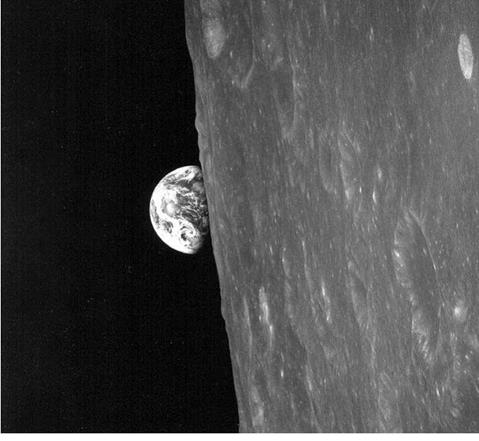APOLLO 8
|
Int. Designation |
1968-118A |
|
Launched |
21 December 1968 |
|
Launch Site |
Pad 39A, Cape Kennedy, Florida |
|
Landed |
28 December 1968 |
|
Landing Site |
Pacific Ocean |
|
Launch Vehicle |
Saturn V AS-503; spacecraft designations: CSM-103; Lunar Module Test Article: LTA-B |
|
Duration |
6 days 3 hrs 0 min 42 sec |
|
Callsign |
Apollo 8 |
|
Objective |
Manned qualification of Saturn V; demonstration of crew, spacecraft and ground support team over lunar mission distance to include lunar orbital operations. |
Flight Crew
BORMAN, Frank, 40, USAF, commander, 2nd mission Previous mission: Gemini 7 (1965)
LOVELL, James Arthur, 40, USN, command module pilot, 3rd mission Previous missions: Gemini 7 (1965); Gemini 12 (1966)
ANDERS, William Alison, 35, USAF, lunar module pilot
Flight Log
The epic Apollo 8 mission began life in 1966 as what would have been Apollo 3, a flight test of the Lunar Module in a highly elliptical Earth orbit, launched on the first manned Saturn V vehicle. This was to follow Apollo 2, which would have been the first low-Earth orbit test of the Lunar Module, following two launches of the Saturn 1B with the Apollo CM and LM respectively, and a rendezvous and docking in Earth orbit. After the Apollo 1 fire, Apollo 2 became Apollo-Saturn 503, to conduct an all-up, Saturn V-boosted test of the modules in Earth orbit; and Apollo 3, with its original objectives, became Apollo-Saturn 504. AS-503, which was to become known as Apollo 8, was due to take place in late 1968, soon after Apollo 7 returned to Earth, but it became clear that the Lunar Module for the mission would not be ready in time.
At the same time, the Soviets had completed an unmanned, recoverable, lunar looping mission with Zond 5, basically an unmanned Soyuz craft without the Orbital Module, launched on a Proton vehicle. A hyped-up NASA clearly expected a manned Zond lunar looping flight soon and offered the commander of Apollo 8 the chance to make a lunar orbital mission, without his Lunar Module. The commander, James McDivitt, refused and decided to wait for his module. NASA therefore brought the Apollo-Saturn 504 mission forward as Apollo 8, and its crew was prepared for the lunar mission, which was given even more impetus when Zond 7 made another lunar
|
Earth rise |
loop, this time making a landing inside the Soviet Union after a relatively benign 7-G re-entry.
As Apollo 8 was readied for history, there were rumours that Zond 8 was on the pad, with a lone cosmonaut atop a Proton preparing to beat the USA to the Moon. Despite the rumours, it is unlikely that the flight was ready in time. So, with much ado, Frank Borman, Michael Collins and William Anders made ready, only for Collins to be replaced by James Lovell when it was discovered that he needed back surgery.
Apollo 8 captured the imagination of the world. Watched worldwide live on television, the Saturn V thundered off the pad at 07:51 hrs local time on 21 December. Apollo 8 was in 32.6° inclination, 182-188 km (113-117 miles) Earth orbit in 11 minutes 25 seconds, still attached to the S-IVB third stage, which reignited at T + 2 hours 50 minutes. The 5 minute 17 second burn propelled Apollo 8 to a speed of 38,761 kph (24,086 mph) – escape velocity. Man was leaving the Earth for the first time. Gradually the Earth reduced in size and the crew beamed back live TV to
incredulous viewers, caught up in the emotion and history of the epic mission. A major milestone occurred as Apollo’s speed had dwindled to 3,556 kph (2,215mph) some 62,240 km (38,676 miles) from the Earth, as lunar gravity took control and the speed increased. Two mid-course manoeuvres later, on Christmas Eve at T + 68 hours 58 minutes 45 seconds, the Earth lost contact with the Apollo crew as it disappeared behind the Moon, the first people to be cut off from their home planet.
The SPS engine ignited for 242 seconds, reducing the speed of the spacecraft from 8,000 kph (4,971 mph) to 5,953 kph (3,699 mph) and lunar orbit was achieved, only confirmed to the rest of the world when Apollo 8 reappeared on the other side of the Moon. The initial orbit of 112-308km (70-191 miles) was circularised at 112km (70 miles) by a second SPS burn on the third orbit. The highlight of the twenty lunar orbits was the crew’s message of goodwill on Christmas Day, including the reading of passages from Genesis from the Bible. Twenty hours 11 minutes in lunar orbit ended with an SPS burn of 203.7 seconds, again on the unseen far side of the Moon.
Thankfully, Apollo 8 emerged triumphantly from the other side and began the journey home, which was to end with a dramatic, double-skip re-entry, at a speed of 39,513kph (24,553mph), during which the Command Module gained 9,144m (30,000 ft) altitude, losing momentum before descending into the atmosphere for the final plunge. The mission ended with a splashdown at 8° north 165° west in the Pacific Ocean at mission elapsed time of 6 days 3 hours 0 minutes 42 seconds. The three men, who were hailed as the Columbuses of the Space Age, were aboard the USS Yorktown 88 minutes later.
Milestones
28th manned space flight 18th US manned space flight 2nd Apollo CSM manned mission
1st manned space flight to achieve escape velocity, approx 22,500 mph (36,202 kph)
1st manned flight to the Moon 1st manned flight to orbit the Moon
1st manned spacecraft to enter atmosphere from lunar distance, at 24,681 mph (39,713 kph)











